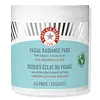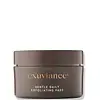What's inside
What's inside
 Key Ingredients
Key Ingredients

 Benefits
Benefits

 Concerns
Concerns

 Ingredients Side-by-side
Ingredients Side-by-side

Water
Skin ConditioningAloe Barbadensis Leaf Juice
Skin ConditioningGlycerin
HumectantCucumis Sativus Fruit Extract
EmollientLactic Acid
BufferingGlycolic Acid
BufferingLeuconostoc/Radish Root Ferment Filtrate
AntimicrobialChrysanthemum Parthenium Extract
Skin ConditioningSodium Hydroxide
BufferingPolysorbate 20
EmulsifyingCamellia Sinensis Leaf Extract
AntimicrobialGlycyrrhiza Glabra Root Extract
BleachingCitrus Nobilis Fruit Extract
MaskingCitrus Limon Peel Extract
EmollientHyaluronic Acid
HumectantPhyllanthus Emblica Fruit Extract
HumectantEDTA
Tetrasodium EDTA
Phenoxyethanol
PreservativeChlorphenesin
AntimicrobialWater, Aloe Barbadensis Leaf Juice, Glycerin, Cucumis Sativus Fruit Extract, Lactic Acid, Glycolic Acid, Leuconostoc/Radish Root Ferment Filtrate, Chrysanthemum Parthenium Extract, Sodium Hydroxide, Polysorbate 20, Camellia Sinensis Leaf Extract, Glycyrrhiza Glabra Root Extract, Citrus Nobilis Fruit Extract, Citrus Limon Peel Extract, Hyaluronic Acid, Phyllanthus Emblica Fruit Extract, EDTA, Tetrasodium EDTA, Phenoxyethanol, Chlorphenesin
Water
Skin ConditioningButylene Glycol
HumectantGluconolactone
Skin ConditioningPolysorbate 80
EmulsifyingPropylene Glycol
HumectantLactobionic Acid
BufferingTocopheryl Acetate
AntioxidantTetrahexyldecyl Ascorbate
AntioxidantCamellia Sinensis Leaf Extract
AntimicrobialChondrus Crispus Extract
Skin ConditioningCucumis Sativus Fruit Extract
EmollientCitrus Grandis Peel Oil
MaskingCitric Acid
BufferingArginine
MaskingPolysorbate 20
EmulsifyingSodium Hydroxide
BufferingCaprylyl Glycol
EmollientDisodium EDTA
Chlorphenesin
AntimicrobialPhenoxyethanol
PreservativeWater, Butylene Glycol, Gluconolactone, Polysorbate 80, Propylene Glycol, Lactobionic Acid, Tocopheryl Acetate, Tetrahexyldecyl Ascorbate, Camellia Sinensis Leaf Extract, Chondrus Crispus Extract, Cucumis Sativus Fruit Extract, Citrus Grandis Peel Oil, Citric Acid, Arginine, Polysorbate 20, Sodium Hydroxide, Caprylyl Glycol, Disodium EDTA, Chlorphenesin, Phenoxyethanol
 Reviews
Reviews

Ingredients Explained
These ingredients are found in both products.
Ingredients higher up in an ingredient list are typically present in a larger amount.
Camellia Sinensis Leaf Extract is derived from the leaves of the tea plant. Black tea, green tea, and oolong tea are all harvested from this plant.
This ingredient has many skin benefits:
This ingredient contains polyphenols, a strong antioxidant. Antioxidants help fight off molecules that damage skin cells.
On top of that, the antioxidants in green tea neutralize free-radicals from the sun. This gives the skin some extra UV protection, but should not replace sunscreen.
Many components of tea have anti-inflammatory properties.
Polyphenols and L-theanine help soothe the skin and reduce irritation. The caffeine in Camellia Sinensis Leaf Extract helps calm inflamed blood vessels.
Other compounds found in tea include: Vitamin Bs, linoleic acid, magnesium, calcium, iron, and zinc.
Research has shown both drinking Camellia Sinensis Leaf Tea and applying it to the skin can help boost skin elasticity and hydration. Studies also show using tea extract may reduce sebum, or oil, production.
Learn more about Camellia Sinensis Leaf ExtractChlorphenesin is a synthetic preservative. It helps protect a product against bacteria in order to extend shelf life. In most cases, Chlorphenesin is paired with other preservatives such as phenoxyethanol and caprylyl glycol.
Chlorphenesin is a biocide. This means it is able to help fight the microorganisms on our skin. It is also able to fight odor-releasing bacteria.
Chlorphenesin is soluble in both water and glycerin.
Studies show Chlorphenesin is easily absorbed by our skin. You should speak with a skincare professional if you have concerns about using Chlorphenesin.
Learn more about ChlorphenesinThis extract comes from cucumber. Cucumbers are mostly made up of water (95%), and the other 5% is composed of: vitamin C, caffeic acid, fatty acids, amino acids, and other minerals.
Cucumbers have anti-inflammatory, barrier repair, and hydrating properties.
They contain shikimate dehydrigenase, an enzyme shown to help reduce inflammation and soothe the skin.
The amino acids found in cucumbers help nourish our skin's natural acid mantle (it's an important part of our skin barrier). This slightly acidic film acts as a barrier to protect us from bacteria, viruses, and other contaminants.
Unless you have an allergy to cucumbers, this is generally a non-irritating ingredient.
Fun fact: Cucumis Sativus is native to South Asia and can now be found on every continent.
Learn more about Cucumis Sativus Fruit ExtractPhenoxyethanol is a preservative that has germicide, antimicrobial, and aromatic properties. Studies show that phenoxyethanol can prevent microbial growth. By itself, it has a scent that is similar to that of a rose.
It's often used in formulations along with Caprylyl Glycol to preserve the shelf life of products.
Polysorbate 20 is made by combining ethoxylation of sorbitan, ethylene oxide, and lauric acid. It is a mild cleansing agent, surfactant, and emulsifier.
As a surfactant, it helps collect dirt and oils for washing. Emulsifiers prevent oils and water from separating.
Polysorbate 20 also adds scent to a product. Since it is made using sorbitol, it has a sweet scent. Sorbitol can also be found in fruits such as apples and peaches.
The lauric acid used to create Polysorbate 20 is often derived from coconuts.
Polysorbate 20 may not be fungal acne safe.
Learn more about Polysorbate 20Sodium Hydroxide is also known as lye or caustic soda. It is used to adjust the pH of products; many ingredients require a specific pH to be effective.
In small amounts, sodium hydroxide is considered safe to use. However, large amounts may cause chemical burns due to its high alkaline.
Your skin has a natural pH and acid mantle. This acid mantle helps prevent harmful bacteria from breaking through. The acid mantle also helps keep your skin hydrated.
"Alkaline" refers to a high pH level. A low pH level would be considered acidic.
Learn more about Sodium HydroxideWater. It's the most common cosmetic ingredient of all. You'll usually see it at the top of ingredient lists, meaning that it makes up the largest part of the product.
So why is it so popular? Water most often acts as a solvent - this means that it helps dissolve other ingredients into the formulation.
You'll also recognize water as that liquid we all need to stay alive. If you see this, drink a glass of water. Stay hydrated!
Learn more about Water